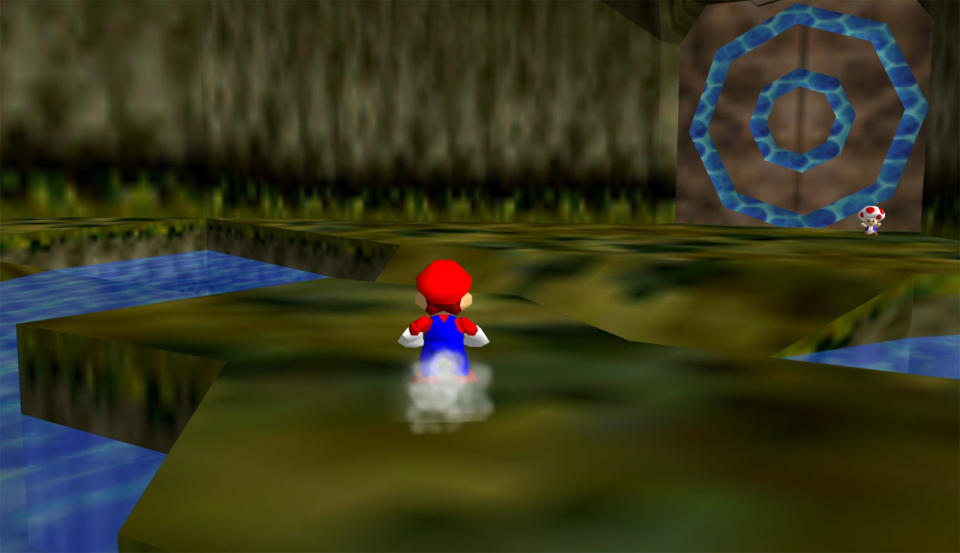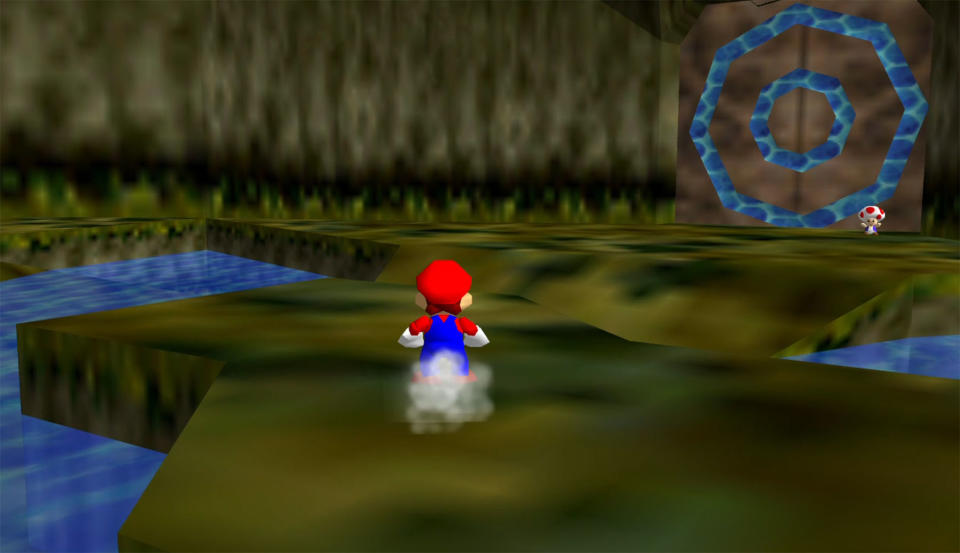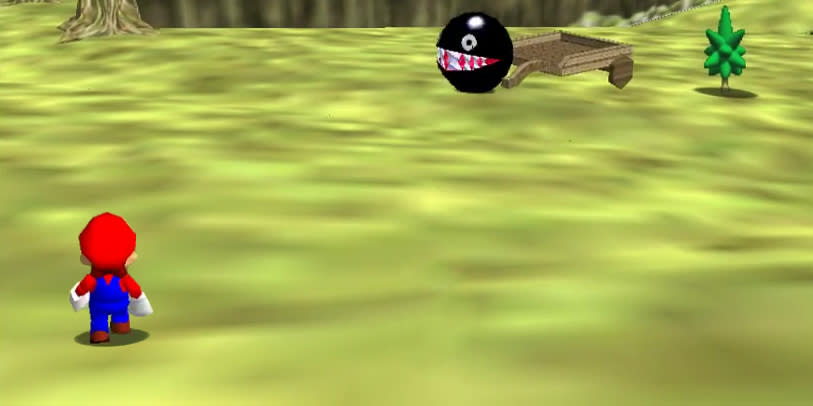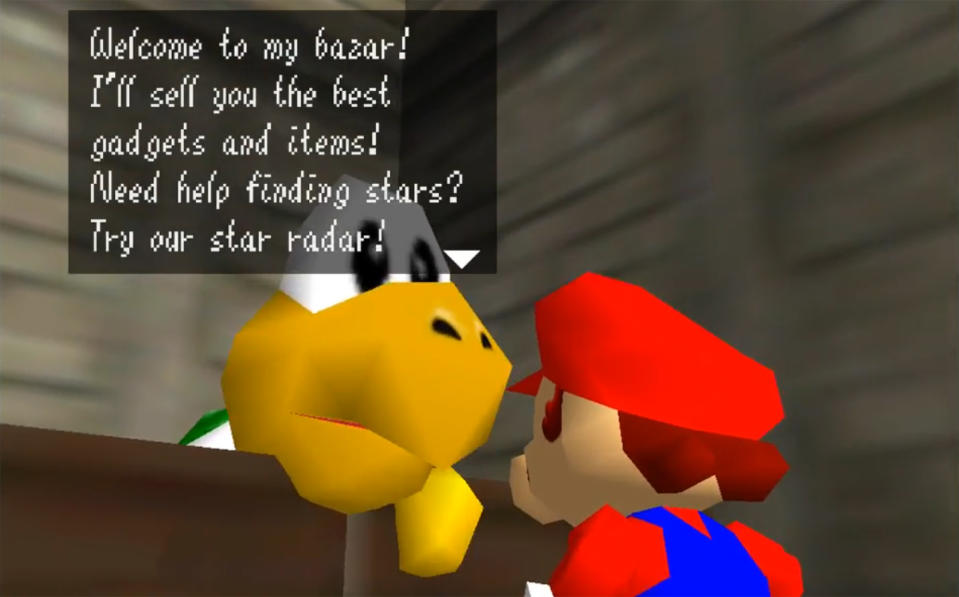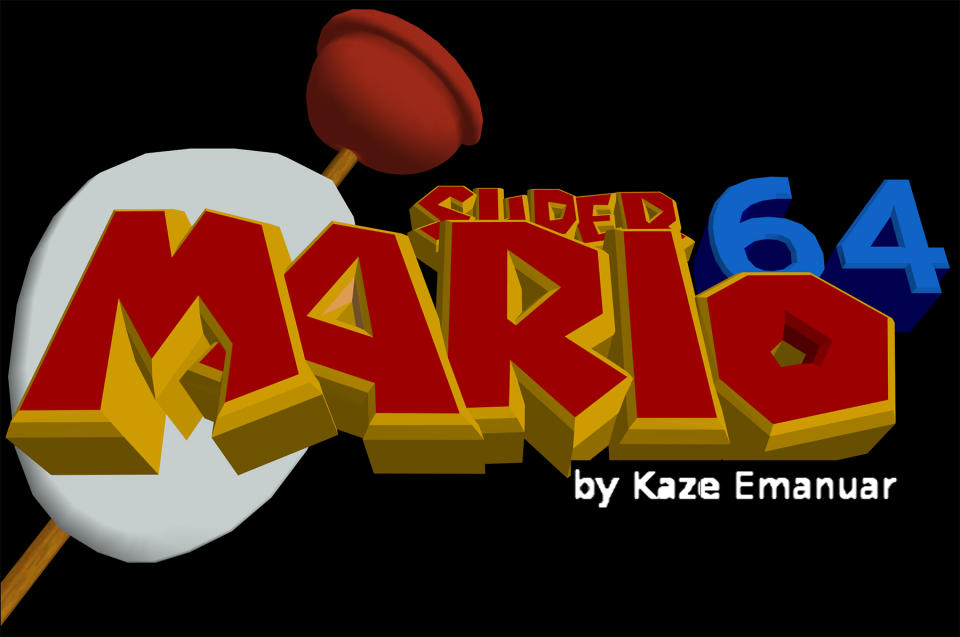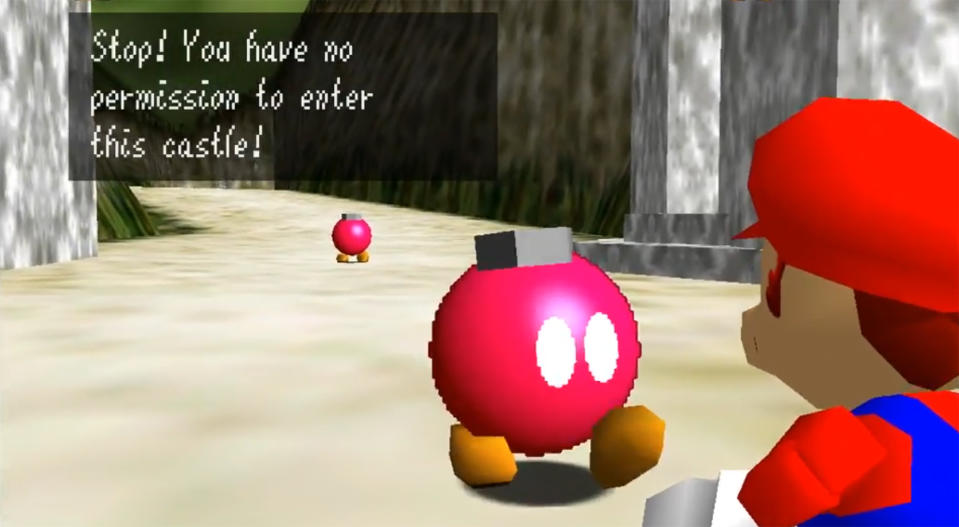'Super Mario 64: Ocarina of Time’ is the perfect Nintendo mashup
Kaze Emanuar has spent five years remixing Nintendo classics.
Super Mario 64 is considered to be one of the greatest video games of all time. Its large, imaginative levels and increasingly difficult challenges have defined the 3D platformer genre since its release on the Nintendo 64. Similarly, The Legend of Zelda: Ocarina of Time — the first in the franchise with 3D graphics — is considered a classic with a record 99 rating on Metacritic. Both have been celebrated with portable re-releases and a deluge of fan movies, artwork and soundtrack remixes. But never have the two games been combined in a fan-made ROM hack like Super Mario 64: Ocarina of Time.
The unofficial and legally dubious project allows players to traverse Hyrule, the mystical kingdom found in the Zelda series, as Nintendo's portly plumber. The world is a little different to the one found in Link's adventure, however. Hyrule Castle, for instance, is owned by Peach and patrolled by pink Bob-ombs. The Forest Temple, located in the Lost Woods, is filled with colorful Boos instead of flaming skulls. Epona, Link's reliable steed, has been replaced with wooden carriages dragged by overzealous Chain Chomps.
The game is a meticulous recreation of Hyrule inside the Super Mario 64 engine. Kaze Emanuar, a prolific modder, rebuilt every house, dungeon and fairy fountain so it would be recognizable to longtime Zelda fans. Each map was adjusted, however, to accommodate Mario's acrobatic move-set -- unlike Link, the mustachioed hero can wall jump, triple-jump and backflip — and the placement of 170 stars. Some rooms are inaccessible or streamlined so that players can quickly reach the next boss or power-up.
It's a bizarre, but perfectly playable mashup that Emanuar has been building toward for five years. He grew up in the German city of Bremen and discovered emulators — applications that mimic older video game hardware — as a 17-year-old in high school. Most people use emulation to quickly (and often illegally) play titles from their childhood. Emanuar's first exposure, however, was through a Super Mario 64 ROM hack called Star Road. He tried to play it with a mouse and keyboard at first but quickly discovered that a controller was almost mandatory. "Playing Mario 64 mods with keyboards," he explained, is "something you should never do to yourself. If you love yourself, and like anyone, you should definitely go and get a USB controller."
Emanuar enjoyed the difficulty of Star Road, which went beyond the challenges found in Super Mario 64. He had been programming games on his calculator and was instantly intrigued by the N64 modding community. "When I saw that Star Road was a thing, I thought 'Yo, this can be done. If this one guy can make this, then I can make it too.'" His first fan hack was Super Mario 64 Madness, a complete game with custom courses and 122 stars. Emanuar was "a total noob" at modding, however, and the final version was awful. "It's so bad, I hid the trailer from my [YouTube] channel," he explained.
"It's so bad, I hid the trailer from my [YouTube] channel."
Mario fans hated the mod and showered Emanuar with insulting reviews. "They called me disabled and everything," he said. Undeterred, Emanuar released a string of mods in 2013 including the five-level adventure Mario and the Magic Wand, the musical-themed Organ of Matrias, and Super Mario Bros 3D, which lets the player choose between Mario and Luigi. With each ROM hack, Emanuar learned more about the game and the modding tools maintained by the community. These include various open-source level, text and texture editors, as well as custom software for importing 3D object and level files.
Next, Emanuar taught himself assembly (ASM) coding, which uses complex, but still human-readable code and an "assembler" program like CajeASM. The technique is vital for modders who want to differentiate from their peers and add custom features to Super Mario 64. Emanuar used ASM to create Lonely Holidays 64 in August 2013 and Peach's Christmas Invitation that December. Though short, these hacks contained many unique enemies, levels and star challenges. The latter hack, for instance, lets you ride around on Yoshi.
Emanuar hated school. He didn't care much about his grades and planned to study math at University. "For math, you don't need good grades," he said. "So I was just physically there while doing ... whatever." Emanuar would drift off in class and make notes about his next ROM hack. Occasionally he would write assembly code in his folders too. "Just practicing how it works," he explained. "How I could use the logic and the standard better."
The modding took its toll, however. Emanuar was working 17-hour days during the development of Peach's Christmas Invitation. "I didn't do anything but work on that game and sleep," he said. "After that, I just needed a break. I couldn't do it anymore." The modder also felt he'd done everything he could with Mario 64. But he hadn't -- not by a long shot.

Emanuar took a six-month break and then returned with the self-explanatory Kaze's Warmup. The mini-hack had 14 stars strewn across two custom levels, Mad Monster Mansion and Metal Harbour. Emanuar used the game to practice custom modeling, which would benefit later mods including Super Mario 64: Ocarina of Time.
In late 2014, Emanuar graduated from high school and moved on to University. He also released Super Mario 64: Chaos Edition, a twist on the original game that randomly activated cheat codes during each session. Almost all of them were designed to infuriate; one minute Mario couldn't jump, the next he would perform "super high jumps" or be unable to open doors. Music would speed up or be replaced with a rendition performed by a Mario impersonator. Other times, Mario would be squashed or suddenly attacked by Boos disguised as wing caps.
Chaos Edition was popular with YouTube streamers including PeanutButterGamer and Vinesuace. Over the next two years, Emanuar would update it five times with much-needed bug fixes and additional cheat codes. "I made a bunch more versions because people really liked the game," he said. "I wanted to give them more." Emanuar's proudest achievement that year, however, was a festive mod called Halloween Mayhem. It was a colorful, polished production with eight imaginative courses including Deadly Slide and Cursed Egyptian Tomb. According to Emanuar, the quality can be attributed to his friend and collaborator Kinopio, whom he described as "a really, really talented modeler."
That same year, Emanuar started working on a new mod called Last Impact. The goal was simple: to build a ROM hack that eclipsed Star Road in scale and complexity. With two years of modding experience, and an in-depth knowledge of assembly code, he was confident of besting Skelux's project from 2011. "Everyone was like, 'Oh, Star Road is the biggest, most ambitious hack with the most custom coding. And I was like, 'I can do a lot more crazy shit than that.'" From the start, Emanuar wanted the game to have 130 stars and some "crazy custom object stuff." It wasn't until 2016, however, that the public would see the finished article.

Before its release, Emanuar worked on a Chaos Edition for The Legend of Zelda: Ocarina of Time. Like its Mario sibling, the ROM hack offered a variety of randomly activated cheat codes. It was popular, but few players made it past the early Deku Tree mini-dungeon. "It is barely functional at the best of times and an unplayable mess that requires an almost paranoid level of save-stating and frame delimiters at its worst," one player commented.
Chaos Edition is the only time Emanuar has modded Ocarina of Time directly. It's not because the game is harder to hack — it's just less interesting to modders and players alike. That's partly because The Legend of Zelda has a more complicated design. Modders can build 3D platformers with a simple, point-to-point progression. An RPG, however, requires elaborate puzzles, side quests and equipment upgrades. "It's really easy to screw it up," Emanuar said. "Whereas is you make a platformer like Mario, you can't really screw up that much. Everyone can make their own Mario game, but making your own Zelda? That's pretty difficult."
As the months wore on, people started asking about Last Impact. Emanuar had taken a break from social media but was maintaining his YouTube channel with the occasional tutorial and announcement trailer. He soon noticed that impatient fans were leaving 10 to 50 comments on his videos every day. Emanuar was "already really stressed out" and decided to prank his followers with another unique mod. He took a hack called Toad-megeddon — which takes place in a world covered in Toad faces — and developed it further with Toad-themed snow, physics, and a pint-sized playable character. It was released on September 12th, 2016 as Super Releasio.
While unexpected, Emanuar's fans appreciated the joke. "The CIA should use this game as torture," one commenter wrote on YouTube. "The sound effects are making me laugh uncontrollably. " Another said: "This is the ultimate hack. We don't need hacks ever again. "
"I was very pessimistic about it. I had no expectations."
Behind the scenes, though, Emanuar was still working on Last Impact. He asked friends to come over and play-test early versions, taking note of game-breaking bugs and unclear signposting. If players, were getting stuck, "I would go to the area to see if I could make it any clearer without bugging people that hadn't run into issues there," he explained. A month before the game's release, Emanuar also organized a beta that anyone could apply for online. More than 1,000 people emailed Emanuar asking to participate. "It was probably the most stressful time in my life," he said, "Because I had to talk to all these people the entire day. And that was after I had been isolated from everyone for three to four months."
Still, he persevered, and Last Impact was released September 30th, 2016. It wasn't too popular, but Emanuar didn't mind. "I was very pessimistic about it," he said. "I had no expectations. So it was not like I was disappointed or anything."

The student continued to experiment with Super Mario 64 over the next 18 months. Some, such as Super Mario Run 64 — an auto-running mini-hack set in a 2.5D world — are throwaway jokes. "When Super Mario Run came out I was like, 'This is silly. This shouldn't be a proper game. This looks like it was made with two to three hours of effort,'" he said. "So then I went and spent two hours making Super Mario Run 64." Others, like Super Trump 64, are meant to be controversial. A smattering, though, are simply impressive in their ability to mimic later Nintendo releases. Super Mario 64 Maker, for instance, is a level editor inspired by the Wii U title. "I thought, 'Mario Maker is such a cool concept. I really have to do this in 3D,'" he said.
In late 2017, Emanuar teamed up with MelonSpeedruns and Marshivolt on a multiplayer ROM hack called Super Mario 64 Online. It allowed up to 24 people to sprint, long jump and side-flip through the original game together. Fans could pick between eight different characters: Mario, Luigi, Yoshi, Peach, Toad, Wario, Waluigi and Rosalina. They all had unique abilities — Yoshi could flutter-jump, for instance, while Rosalina had her Star-Spin — adding to the chaos as users raced through Princess's Secret Slide or played tag in Jolly Roger Bay. It was far superior to the four-player 'Vs. Mode' found in Super Mario 64 DS.
"When 'Super Mario Run' came out I was like, 'This is silly. This shouldn't be a proper game. This looks like it was made with two to three hours of effort.'"
The ROM hack was hugely popular and soon caught the attention of Nintendo. The company, which has long fought against fan-made remakes and mods, filed multiple copyright strikes against Emanuar. These affected his Patreon account — which has since been reinstated — and several YouTube videos that included download instructions. A Nintendo spokesperson said at the time: "Nintendo's broad library of characters, products, and brands are enjoyed by people around the world, and we appreciate the passion of our fans. But just as Nintendo respects the intellectual property rights of others, we must also protect our own characters, trademarks and other content."
Emanuar believes the swift takedown was because Super Mario Odyssey was less than a month away. "If you release something right before Nintendo releases a game, I don't think that's good," he said. "They probably take you down then so that people play their game instead." Super Mario 64 Online lives on, however, through a modified client called Net64+. The community is small but organizes the occasional event through a Discord channel. When faced with a copyright strike, Emanuar now creates a patch that separates his work from Nintendo's original ROM. "You can legally upload that," he explained.

Emanuar began developing Super Mario 64: Ocarina of Time last August. He was intrigued by large, open world games and wondered if it would be possible to build a similar experience inside Super Mario 64. As a longtime fan of Zelda series, he felt the N64 classic would make a good foundation. So he took the original world map and started planning how his own storyline could weave through it. Super Mario 64: Ocarina of Time hews pretty close to Link's original adventure, but there are plenty of original ideas thrown in too. At the start of the game, Peach tells Mario that Bowser is planning to invade the castle with an unstoppable army. He can only be defeated with 9 Grand Stars that are scattered across time and different locales.
"The last five were all sealed by our ancestors within dungeons that we can't access at the moment," Peach explains to an expressionless Mario. "However, the seals are getting weaker, and with the power of three Grand Stars you will be able to enter the Temple of Time and use the Grand Star of Time to travel into the future, where the seals will be weak enough to be broken."
The story, while imaginative, is far removed from a classic Nintendo game. At the end of the adventure, for instance, Mario fights an older version of Bowser hunched over a grand piano. "I'm an old turtle now," he croaks, "but that doesn't mean you'll have an easy time! I'd love to beat you up one last time for nostalgia, but my children are eager to fight themselves. Go get him!" This twisted version of Nintendo's finest villain will, for some, be seen as blasphemy. But Emanuar has a simple explanation: none of his works is canon. "Each ROM hack is a separate universe," he said.
"Each ROM hack is a separate universe."
Development was rather straightforward. Emanuar started with Kokiri Forest — the place where Link starts in Ocarina of Time — and worked forwards through the game. Whenever the modder reached a dungeon, he would stop and start dreaming up puzzles appropriate for Mario. The student soon realized, however, that a direct recreation wouldn't be very enjoyable. Some rooms, for instance, "were just useless" or unnecessarily confusing for the player. That's why only a third of each dungeon is required to beat Super Mario 64: Ocarina of Time. The rest is devoted to optional stars and secrets. "I feel like that's a better fit for modern audiences," he explained, "rather than doing the whole dungeon because people don't have the patience anymore."

The mod was released on March 26th, 2018. The reaction was overwhelmingly positive; multiple streamers and press outlets have covered the game since its launch. But Emanuar isn't done yet. Since Super Mario 64: Ocarina of Time, he's released Portal Mario 64, a game based on Valve's beloved puzzler, and a version of Mario 64 running in 4K at 60 frames-per-second. The modder is now working on a slew of follow-up hacks inspired by PUBG and Fortnite, the romance simulator Doki Doki Literature Club, and others.
Emanuar has considered modding other games, such as the Sega Dreamcast platformer Sonic Adventure. But he's stuck with Mario 64 because of its divisive controls and physics — which he loves — and the sheer amount of hours he's poured into the game. Emanuar is still a student, but he's spent 10 hours each day, for roughly five years, dissecting Nintendo's seminal platformer. "If I was gonna do that with another game," he said, "I would have to spend at least a year of full-time work before I was anywhere near the level I am with Super Mario 64."
The modder makes some money through YouTube and Twitch. However, it's "an awful wage" for the amount of work he puts into each project. In the end, Emanuar is making mods for the love of it. "I really enjoy it still," he said. Nintendo, of course, will never approve — but for countless fans around the world, ROM hacks like Super Mario 64: Ocarina of Time are a beautiful love letter to some of their favorite worlds and characters.


